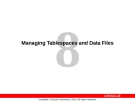
Managing tablespaces
-
Small shared pool Small database buffer cache Small redo log buffer cache Missing indexes Rollback segments and undo tablespace Sort area size incorrectly set Assorted
 16p
16p  trinh02
trinh02
 28-01-2013
28-01-2013
 54
54
 6
6
 Download
Download
-
Managing Privileges A privilege is a right to execute a particular type of SQL statement or to access another user’s object. These include the right to: Connect to a database Create a table Select rows from another user’s table Execute another user’s stored procedure System privileges Each system privilege allows a user to perform a particular database operation or class of database operations; for example, the privilege to create tablespaces is a system privilege.
 26p
26p  trinh02
trinh02
 28-01-2013
28-01-2013
 73
73
 5
5
 Download
Download
-
After completing this lesson, you should be able to do the following: Describe the concept of automatic undo management Create and maintain the automatic managed undo tablespace Set the retention period Use dynamic performance views to check rollback segment performance Reconfigure and monitor rollback segments Define the number and sizes of rollback segments Allocate rollback segments to transactions
 36p
36p  trinh02
trinh02
 28-01-2013
28-01-2013
 46
46
 7
7
 Download
Download
-
Tablespaces and Data Files Databases, tablespaces, and data files are closely related, but they have important differences: An Oracle database consists of one or more logical storage units called tablespaces, which collectively store all of the database’s data. Each tablespace in an Oracle database consists of one or more files called data files, which are physical structures that conform with the operating system in which Oracle is running. A database’s data is collectively stored in the data files that constitute each tablespace of the database.
 52p
52p  trinh02
trinh02
 28-01-2013
28-01-2013
 67
67
 6
6
 Download
Download
-
After completing this lesson, you should be able to do the following: List the operations that use temporary space Create and monitor temporary tablespaces Identify actions that use the temporary tablespace Describe the use of disk and memory for sorting Identify the SQL operations that require sorts Differentiate between disk and memory sorts List ways to reduce total sorts and disk sorts Determine the number of memory sorts performed Set parameters to optimize sorts
 32p
32p  trinh02
trinh02
 28-01-2013
28-01-2013
 45
45
 6
6
 Download
Download
-
After completing this lesson, you should be able to do the following: List the advantages of distributing different Oracle file types Diagnose tablespace usage problems List reasons for partitioning data in tablespaces Describe how checkpoints work Monitor and tune checkpoints Monitor and tune redo logs
 34p
34p  trinh02
trinh02
 28-01-2013
28-01-2013
 58
58
 4
4
 Download
Download
-
Chức Năng : Chứa toàn bộ dữ liệu trong database. Lưu Trữ các dữ liệu thuộc cấu trúc logic của database như tables hay indexes Tính Chất Mỗi datafile chỉ có thể được sử dụng trong một database. Một số tính chất cho phép tự động mở rộng kích thước mỗi khi database hết chỗ lưu trữ dữ liệu. Một hay nhiều datafiles tạo nên một đơn vị lưu trữ logic của database gọi là tablespace. Một datafile chỉ thuộc về một tablespace....
 57p
57p  trinh02
trinh02
 28-01-2013
28-01-2013
 153
153
 25
25
 Download
Download
-
Types of Recovery Manager Backups Recovery Manager provides functionality to back up: The entire database, every datafile in a tablespace, or a single datafile The control file All or selected archived logs Note: The online redo log files are not backed up when using Recovery Manager. Closed Database Backups A closed database backup is defined as a backup of the database while it is closed (offline). This is the same as the consistent database backup. If you are performing a closed backup, the target database must not be open.
 46p
46p  trinh02
trinh02
 28-01-2013
28-01-2013
 69
69
 6
6
 Download
Download
-
In either case, the easiest way is to drop the entire tablespace that contains the datafile. The steps that are to be executed from within SQL*Plus are: 1. STARTUP MOUNT 2. For each deleted datafile, issue the command ALTER DATABASE DATAFILE ’full path of filename’ OFFLINE [DROP]; Note: You must use the DROP option if the database is in NOARCHIVELOG mode, because you cannot recover this file if you apply incomplete media recovery on it via the command ALTER DATABASE OPEN RESETLOGS. See the SQL Reference for details. 3. ALTER DATABASE OPEN; 4.
 14p
14p  trinh02
trinh02
 28-01-2013
28-01-2013
 47
47
 4
4
 Download
Download
CHỦ ĐỀ BẠN MUỐN TÌM





















